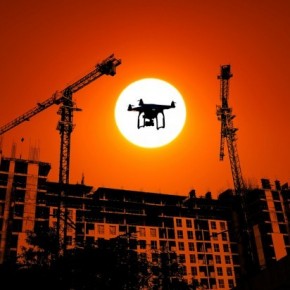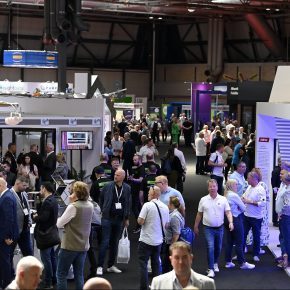
The drone revolution: How drone tech is transforming construction
Darren Harding of Uplift Drone Training believes drone technology is set to revolutionise the construction industry. How exactly does he think it will happen?
The world is in the grips of revolution — and not just one.
Whether they be political, the dividing or unification of nations, environmental, moving forwards on issues that impact our future, economical, or a rise in countries to financial dominance, we simply cannot escape momentous change.
There is one such revolution, however, that has largely escaped the headlines. Yet, it is one that will have major and lasting impacts. This revolution is the drone revolution, and it is happening now.
Within three years, analysts are predicting the drone market will rise by 6000%, going from a global value of $2 billion in 2017 to $127 billion in 2020. This extreme surge is being credited to increased affordability, a better understanding of the technology, and the practical applications it can have within multiple industries. Industries like construction.
The construction sector is expected to see perhaps the most far-reaching and dramatic of shifts thanks to the rise of drone technology, but how are things changing?
Faster surveying and project preparation
Those in construction know that proper land surveying is essential to any build project, yet it is a time-consuming, expensive and laborious process.
Drones offer a faster and superior solution to normal processes.
Advanced drone technologies exist to create detailed 3D surveys that allow for accurate information about ground stability, gradients, potential problem areas and more. This process can be carried out quickly through aerial imaging conducted through drone flights.
With detailed imaging available, preparation for a build project can be completed at a much faster rate, as much as 90% quicker than through standard practices. The result is that work gets underway much sooner than it would have.
Better health and safety
As the above point suggests, camera-mounted drones can be used to carry out very complex and highly technical tasks, but they can also be used for more simplistic responsibilities.
Construction site health and safety is an area that is constantly striving for improvement. With 45 deaths in the UK across the construction industry in 2016, the figure may be lower than previous years, but it is still 45 too many. Endangering workforces is something businesses are keen to avoid, both from a humanitarian point of a view and a legal one.
Drones provide valuable resources in the fight for better health and safety, They do this in three key ways:
- Management can use drones to survey work as it is carried out. They can observe and ensure that, even across large construction sites, the workforce is carrying out appropriate safety protocol.
- Drones can also be used to carry out tasks that would be dangerous for employees to undertake — for example, checking for potential issues in high-altitude locations or carrying out repairs in precarious places.
- Drone technology can be utilised to regularly monitor construction sites, looking out for new or missed hazards that could potentially endanger workers on the ground.
Improved mapping and progress monitoring
During 2015, a construction company used drones to map out the development of a stadium build. Every day, they would use drones to collect video footage of the site, which would then be rendered into a comprehensive 3D model. This 3D model was then compared to a model of the finished build.
The construction company was able to track the progress of the build against their time constraints, looking for areas falling behind and allocating resources accordingly. The process was far more efficient and accurate than simple monitoring with the human eye. Problems that might not have been spotted for lengthy periods could be found in a matter of days.
This digital overview ensured the project met deadlines and that problems were caught and dealt with before they could hamper progress and increase build costs. Although not currently utilised within most construction sites, thanks to its previous successes, this mapping technique is set to see a considerable rise in popularity as drone tech becomes more accessible in the future.
More efficient off-site project management
Depending on the size of a construction project, the management team may vary from a few personnel to a whole legion of people, each with their specific tasks and projects to carry out.
Under current construction management models, these members often visit sites to assess progress, support task completion and make decisions. However, with drone technology, time on-site can be dramatically reduced.
Drones can be used by management to get real-time access to construction sites. Their versatility and limitless mobility results in highly-accessible construction sites that can be managed remotely.
Instead of the currently inefficient techniques, managers can take complete control of remote site monitoring, gathering the information on employees and progress that is essential to them without expending time and resources on travel and lengthy site visits.
This instant accessibility, no matter where management is, also means that decisions — and, more importantly, changes — can be made actively, instead of waiting until visits. As a result, if plans change, they can be done so as early as possible, reducing backtracking and time wasting.
Simply put, drones utilised for management mean money saved and extra time awarded to valuable personnel.
Conclusion: the effects of drones in the construction industry
The benefits of the drone revolution upon the construction industry are plain to see. Increased efficiency and reduced costs result in more lucrative projects for construction companies. With these more lucrative construction jobs comes the ability for companies within the sector to expand, grow and commit to more projects.
Investing in the future through resources like high-end UAV technology and drone mapping courses is the key to construction companies taking advantage of the drone revolution and its benefits.
Of course, there is also concern around the rise of drones. As drones take the place of workers in areas such as surveying and site monitoring, these workers become obsolete. Jobs are on the line.
As the revolution continues, it is impossible to argue that jobs will not be lost, however, there are gains to be made here, too. Drones require operators, maintenance and management. With increased efficiency and more building projects comes a great number of staff required to undertake jobs.
Drones in construction mean a shift in opportunities for workers in the industry. What is required of the workforce is that it adapts to these changes, filling in the various new and evolved skills required for drones to be an effective tool within the sector.
One comment on “The drone revolution: How drone tech is transforming construction”
Leave a Reply
You must be logged in to post a comment.
Latest news

9th April 2025
Insight Data: Smart spending - how targeted marketing offsets rising costs
As ‘Awful April’ lands, fenestration businesses must use data-driven marketing to maximise impact, cut waste and stay ahead, says Alex Tremlett, Insight Data’s commercial director…
Posted in Articles, Building Industry News, Building Products & Structures, Building Services, Doors, Glass, Information Technology, news, Posts, Research & Materials Testing, Windows
9th April 2025
Saniflo: Retrofit 2025 at the Building Centre
Saniflo is delighted to announce a six-month collaboration with the Building Centre as a Principal Partner for ‘Retrofit 2025 – What’s Stopping Us’.
Posted in Articles, Bathrooms & Toilets, Bathrooms, Bedrooms & Washrooms, Building Industry Events, Building Industry News, Building Products & Structures, Building Services, Case Studies, Drainage, Exhibitions and Conferences, Facility Management & Building Services, Innovations & New Products, Interiors, Pipes & Fittings, Plumbing, Restoration & Refurbishment, Retrofit & Renovation
9th April 2025
FIT Show Launches Comprehensive CPD Learning Programme - Registration Now Open!
FIT Show, the UK’s leading trade event for the window, door, flat glass, hardware, components, and roofing industries, has unveiled its extensive learning programme for the 2025 event.
Posted in Architectural Ironmongery, Articles, Building Industry Events, Building Industry News, Building Products & Structures, Building Services, Building Systems, Continuing Professional Development (CPD's), Doors, Exhibitions and Conferences, Glass, Glazing, Innovations & New Products, Posts, Restoration & Refurbishment, Roofs, Seminars, Timber Buildings and Timber Products, Training, Windows
8th April 2025
First look at industry speakers for GEO Business 2025
GEO Business, the UK’s premier geospatial event, is set to return to ExCeL London on 4 – 5 June 2025, bringing together the brightest minds in the industry.
Posted in Articles, Building Industry Events, Building Industry News, Building Products & Structures, Building Services, Exhibitions and Conferences, Information Technology, Innovations & New Products, Restoration & Refurbishment, Retrofit & Renovation, Seminars

The use of UAV`s (Drones) will have a massive impact on the industry in the future. Huge investment is being made by companies to enable them to use the data produced by Drones. I think the law surrounding their use will be tightened by the Civil Aviation Authority (CAA). A lot of construction companies are flying them totally illegally at the moment. You must have a license to fly them commercially.